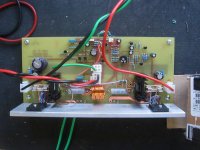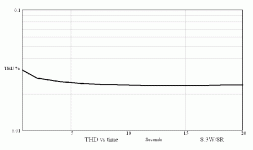jgedde said:Hi Glen,
I hadn't used one since college - 20 years ago! They're a fun toy! I'm still learning all the things they can do, but I figure I'll soon wonder how I ever got by without one! I don't have to now; as my understanding is I don't have to return them... They're "out of service." One works as new after its calibration was tweaked (it was taken out of service after failing calibration back in '99 and was never adjusted back) and switch contacts were cleaned up. The second works but has a trace so dim that it's unusable - I don't think the CRT is bad. The last also works, but the trace cycles in and out of focus. I'm not sure what would cause that....
Hi John.
Nice score! I definitely wouldn't return them. Just in case, report they were all faulty and unserviceable 🙂
If you're looking for a service manual you can download it for free for the Tek page of BAMA:
http://bama.sbc.edu/
I got my 575 manual from there.
Cheers,
Glen
jgedde said:
That's a boat anchor in beautiful shape for sure! Is it tubed or solid state? When was it made? Have fun with it!
John
It's got tubes and transistors inside (hmmm....smell of burning dust). Made in the late 60's I guess.
Cheers,
Glen
ostripper said:
This bring back memories of the synthesisizer tech who used to
match the differential pairs in my ARP 's using just his
oscilloscope and a "jig" for devices😎 .
OS
I remember those ARP synth's sooner or later they sounded like a helicopter, Flaf flaf flaf flaf
🙂
By the way John
Are you able to make curves of the h-parametres?
Stinius
stinius said:
By the way John
Are you able to make curves of the h-parametres?
Stinius
Of course. One can determine the h-parameters using the 576. I haven't done that in 20 years! Maybe I'll find out how senile I've become.
John
jgedde said:
Of course. One can determine the h-parameters using the 576. I haven't done that in 20 years! Maybe I'll find out how senile I've become.
John
John
It's more than 30 years since I did that, but to have the h-parametre curves would be very nice.
Stinius
jgedde said:
That's a boat anchor in beautiful shape for sure! Is it tubed or solid state? When was it made? Have fun with it!
John
John,
Did you get my mail?
JPV
G.Kleinschmidt said:It IS a transistor curve tracer. BTW, I made a boo boo. It's a 575.
Great and very useful tool.
Not only for transistor matching 🙂
Lucky you ...
Typically, the first thing people do to it is disable the interlock on the collector voltage. It's a pita when you flip to 75 volts and that yeller light says "danger will robinson..".jgedde said:.....I hadn't used one since college - 20 years ago! They're a fun toy! I'm still learning all the things they can do.........
John
Watch out for the dissipation limiting resistors, the one here had several that were toast.
One a these days, I'll stop by on the way home...
Cheers, John
John,
Did you get my mail?
JPV
Yes I did. I was trying to think of a way we could get them to me soon enough so I didn't need to delay my test. Also, how to get payment to ship them to Europe when done... I'll probably run the test tomorrow.
John
jneutron,
One of the units I received has a MCTC asset tag. I wonder if it's the same one you used...
John
One of the units I received has a MCTC asset tag. I wonder if it's the same one you used...
John
The 4302's arrived today as expected. I modified the 576 to bring out the current sense. Now I can use a recording DSO in XY mode to record raw data in CSV format of the curves the 576 generates. This is done and tested and I'm ready to roll... We'll see if I have any free time to do the testing tomorrow...
John
John
jgedde said:jneutron,
One of the units I received has a MCTC asset tag. I wonder if it's the same one you used...
John
Yes, it is.
I was the only one who used 576's there.
Cheers, John
Moderator's help needed
I'm hopeful that one of the moderators will see this and take action. Doug Self has been unable to post for about 5 days. It is apparently unclear what the problem is, but I hope that someone will get it resolved.
He has some likely interesting ThermalTrak measurement results ready to post that I'm sure we would all like to see.
Cheers,
Bob
I'm hopeful that one of the moderators will see this and take action. Doug Self has been unable to post for about 5 days. It is apparently unclear what the problem is, but I hope that someone will get it resolved.
He has some likely interesting ThermalTrak measurement results ready to post that I'm sure we would all like to see.
Cheers,
Bob
Re: Moderator's help needed
That is good news, I look forward too read them.
Bob
If he can't post them himself, maybe he can e-mail you so that and can post them.
Stinius
Bob Cordell said:I'm hopeful that one of the moderators will see this and take action. Doug Self has been unable to post for about 5 days. It is apparently unclear what the problem is, but I hope that someone will get it resolved.
He has some likely interesting ThermalTrak measurement results ready to post that I'm sure we would all like to see.
Cheers,
Bob
That is good news, I look forward too read them.
Bob
If he can't post them himself, maybe he can e-mail you so that and can post them.
Stinius
Re: Moderator's help needed
I pushed the "report" button on this post to bring it to a moderator's attention. Hopefully he can get the problem resolved. I too look forward to his latest results.
Bob Cordell said:I'm hopeful that one of the moderators will see this and take action. Doug Self has been unable to post for about 5 days. It is apparently unclear what the problem is, but I hope that someone will get it resolved.
I pushed the "report" button on this post to bring it to a moderator's attention. Hopefully he can get the problem resolved. I too look forward to his latest results.
We've had some intermittent problems with certain IP addresses. I'll make sure that our webmaster sees this. Thanks, Andy and Bob.
jgedde said:Douglas,
There is one possible explanation for both the 20 second dip at start-up and the fact you need 4 diodes...
It really seem as if there is another tempco at work here... You said you're using an EF type driver stage. I would strongly suspect the tempco of the output stage drivers are coming into play here. They must be carrying their own standing current, and their Vce isn't zero. Therefore, they are dissipating power. Since theta-ja is typically a large number, in 200 seconds, I wouldn't expect any huge change in case temperature, at least not with the finger test. 😀
So, you would have two tempcos that are changing; and not necessarily in sync with each other giving a second order total tempco.
An IR thermograph of your 200 second run would be invaluable as far as verifying whether this is so.
Where are the drivers mounted? On your main heatsink? Or do they have their own? Do they even have/need a sink?
The "finger test" reminds me of the many times I've gotten a DIP tattoo...
Hi there
It's good to be back! Thanks to all for alerting the mods.
It is possible that the driver Vbe's are contributing to the results we see, but I think it is unlikely. I did my best to keep the drivers cool. They are mounted on separate heatsinks (quite large ones for the small power dissipation) with no thermal coupling to the main heatsink, and throughout a day's testing they stayed stone cold. Take a look at the driver hsinks on the attached pic of the test amp.
I did some rough checks by measuring the driver Vbe's and this seemed to confirm the driver junctions were not heating significantly. However, I certainly wouldn't rule it out without some more testing.
Attachments
Here are the results of another TTrak test. Here I was measuring the distortion of the under-biased amplifier versus time, as described before. I was looking for some confirmation that the TTrak diodes really do respond faster than conventional methods. I have also found time to turn the AP data into respectable graphs.
The plot below zooms in on the first 20 seconds of the response for conventional compensation with the sensor on top of the output device, taking readings as fast as a AP System-1 can do it, which seems to be something like once a second.
The plot below zooms in on the first 20 seconds of the response for conventional compensation with the sensor on top of the output device, taking readings as fast as a AP System-1 can do it, which seems to be something like once a second.
Attachments
The second plot below similarly shows the first 20 seconds of the first ThermalTrak experiment I did, with the TTrak diodes in series with the driver Vbe-multiplier, and a VAS current of 9.2 mA.
It is clear that the second plot has a faster initial transient. For conventional compensation with the sensor on top of the output device the time-constant (time to reach 63% of final value) is about 2.5 seconds, while for the ThermalTrak case it is about 0.5 seconds. I must admit I was expecting the ThermalTrak response to be faster than that. Two thoughts:
Firstly the AP doesn't take readings fast enough to give very useful time resolution here.
Secondly there may be some wholly non-thermal settling down of amplifier operation during the first seconds- I am thinking particularily of the ripple-filtering in the VAS current-source biasing. That should be fairly easy to check by changing the filtering time-constant and seeing if the THD/time plot changes.
I should like to express my thanks to the Signal Transfer Company http://www.signaltransfer.freeuk.com/, (who sell PCBs of my designs) for ordering the ThermalTraks for me, as I don't have an account with DigiKey myself. Many thanks chaps.
It is clear that the second plot has a faster initial transient. For conventional compensation with the sensor on top of the output device the time-constant (time to reach 63% of final value) is about 2.5 seconds, while for the ThermalTrak case it is about 0.5 seconds. I must admit I was expecting the ThermalTrak response to be faster than that. Two thoughts:
Firstly the AP doesn't take readings fast enough to give very useful time resolution here.
Secondly there may be some wholly non-thermal settling down of amplifier operation during the first seconds- I am thinking particularily of the ripple-filtering in the VAS current-source biasing. That should be fairly easy to check by changing the filtering time-constant and seeing if the THD/time plot changes.
I should like to express my thanks to the Signal Transfer Company http://www.signaltransfer.freeuk.com/, (who sell PCBs of my designs) for ordering the ThermalTraks for me, as I don't have an account with DigiKey myself. Many thanks chaps.
Attachments
- Status
- Not open for further replies.
- Home
- Amplifiers
- Solid State
- On Semi ThermalTrak


